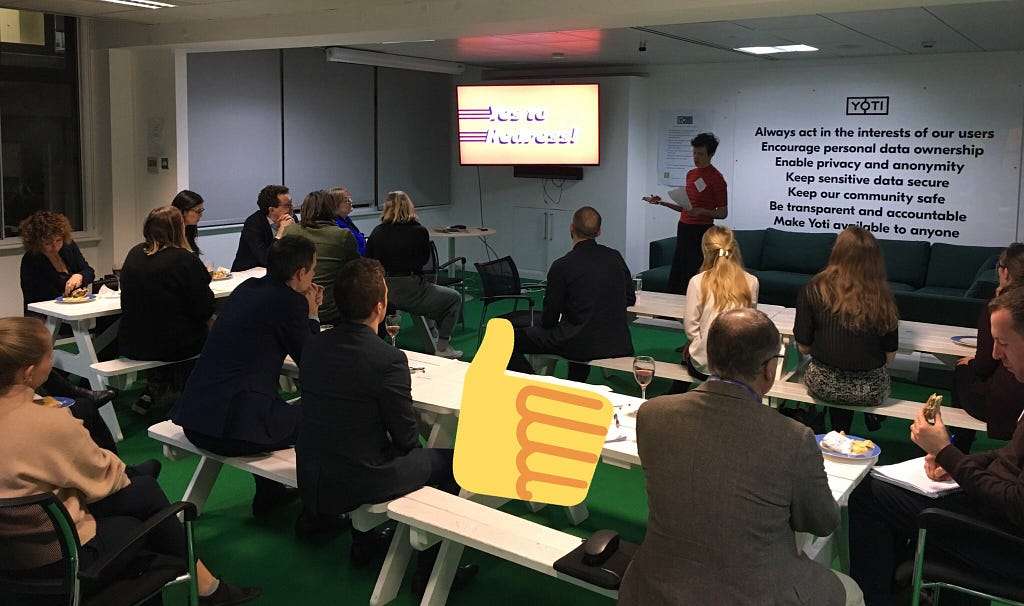What does good redress look like?
Imagining a better system of redress at Yes to Redress! meetup #2

In January with Resolver, the free online tool designed to make complaining quick and easy, we hosted the second in a series of three Yes to Redress! meet-ups.
In our first event in December 2018 we explored the challenges facing our systems of redress in the digital world. In this meetup, we asked: “What does good redress look like?”
This post is a summary of these conversations.
In our Regulating for Responsible Technology report, we explore the challenges facing the digital regulatory landscape and recommend the establishment of an Office for Responsible Technology to tackle them. We see establishing better systems of redress as a core part of the Office’s potential work.
But with the Office yet to come into being, this is an issue that isn’t going anywhere fast.
At our first meetup, we held in December, on the same day the DCMS Committee released the first wave of documents seized from app developer SIx4Three in relation to their legal dispute with Facebook.
The second meetup, held in Yoti’s offices on 6th February, came the same day that Tom Watson, shadow Culture Secretary, spoke out about the fragmented regulatory landscape for tackling tech, and ministers continue to threaten to crack down on the digital giants.
“The harms caused online need to be seen and treated as a public health concern” — Tom Watson
This was not something we engineered. It’s in the news pretty much every day!
So for this second meet-up, in the spirit of this wider conversation, we thought about what good redress looks like, and what we need to do to make that a reality.
Because we need to move away from simply diagnosing the problem, to finding solutions.
Before discussing, we first we heard of three different perspectives from people who are tackling this question in their work.

First, Caroline Sheppard OBE, Chief Adjudicator, Traffic Penalty Tribunal shared what is possible.
Caroline led the development of the first digital tribunal service — an online tool built by Resolver for helping Local Authorities process parking fine disputes. Through the system, appeals are submitted and fully processed online, and the Local Authority sees the appeal and processes it in real-time. The appellants, adjudicators, authorities and administrators can all interact via the system in real-time via live chat, instant messaging, evidence sharing and external email and message prompts.

This virtual hearing leads to fast resolution. The system processes 25,000 cases a year, through 300 Local Authorities. It’s resulted in a 57% reduction in variable costs and led to significant savings — stakeholder authorities have reported savings of £160 per case (totaling £4m in savings to authorities over two years).
Second, Ana Salazar, Policy Executive at Yoti, the digital identity app, articulated some of the challenges facing some sectors, including how there is currently no ombudsman for age verification. She explained that good redress in the digital industry is clear and age appropriate. It’s good to see the ICO calling for input from children and their parents to produce an Age Appropriate Design Code which outlines the “design standards they will expect providers of online services and apps used by children to meet when they process their data”.
Finally, Matthew Vickers, CEO of the Ombudsman Services, called for us to challenge the paradigm in which redress is a transactional, confrontational and individualised process. Often the person who has sought redress (typically a middle-aged, middle-class, university educated, white male) isn’t necessarily left feeling any better after having won their case.
They’re ultimately left feeling greater distrust of the company they’ve been dealing with. So how can we help companies realise that good redress equals trust and that trust is a corporate, system and social asset?
We discussed our vision for a better system of redress where:
- Seeking redress is no longer considered an individualised pursuit
- Good redress is celebrated and people are signposted to where they can go to access it — encouraging more people to seek it
- People are more aware when they have experienced harm which would warrant seeking redress for
- We use tech to help us open up access to redress to a more diverse group of people and earlier in the journey — just as Caroline demonstrated is possible with the online tribunal service for parking fines.
Thank you to everyone who joined us and generously shared your ideas for how we can better support the public to seek redress in the online world.
In the third and final meet-up we’ll be holding in April [date TBC] we will continue to move this work further forward and help people say Yes to Redress!
Please drop me a message if you have any suggestions or ideas for how to move this work forward at [email protected].

What does good redress look like? was originally published in Doteveryone on Medium, where people are continuing the conversation by highlighting and responding to this story.